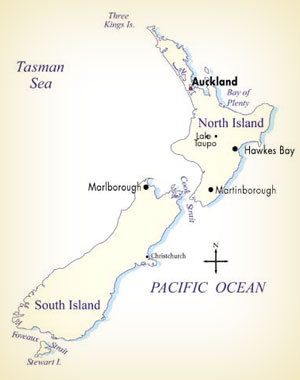The Wines of New Zealand
Growing Regions
New Zealand has a total of nine growing regions, four on South Island and five on North Island.
The principal growing regions are Marlborough, on South Island, and Hawke’s Bay and Gisborne, on North Island. Together, these three regions account for more than 80% of New Zealand’s wine production.
Marlborough, the most famous region, symbolizes the rapid growth and development of the New Zealand wine industry. Today, it’s the largest of New Zealand’s wine regions. And it produces more than 40% of the country’s wines. It is located in the northeast corner of South Island, near the town of Blenheim. The terrain is mainly a large, flat river valley with deep deposits of silt and gravel. But soils vary considerably, even within individual vineyards. The best vineyards are planted in shallow, stony soil, with surface rocks that reflect sunlight and help retain warmth.
Hawke’s Bay is one of the oldest wine growing regions in New Zealand. The first grape vines were planted here in 1851. And by the 1890’s winemakers in the region were already producing notable table wines made from classic vinifera varieties. Today Hawke’s Bay is still one of the country’s premier wine growing regions. It’s second in volume and importance only to Marlborough. The Wairarapa region is located at the southernmost end of North Island. It’s about an hour away from New Zealand’s capital city of Wellington.
The region includes only a small vineyard area. But more than 12% of the country’s wineries are located here. Most of these wineries are small, but they have built an excellent reputation for Pinot Noir and Chardonnay. Despite its somewhat cool growing climate, the region has also produced some of the country’s best examples of Cabernet Sauvignon.
